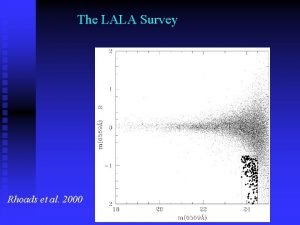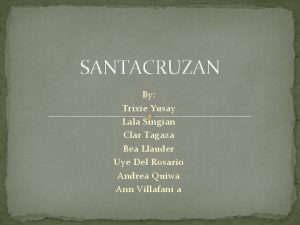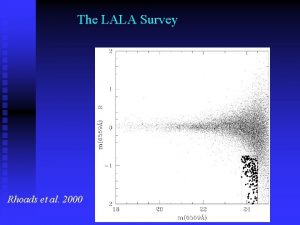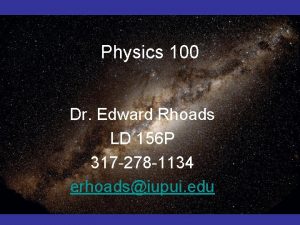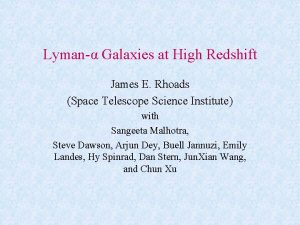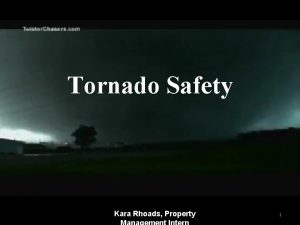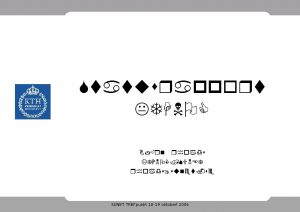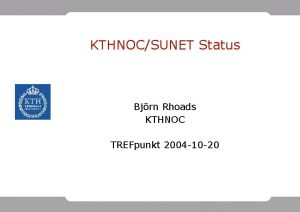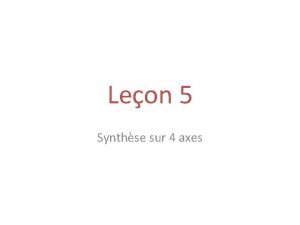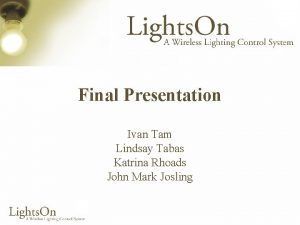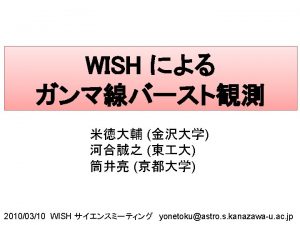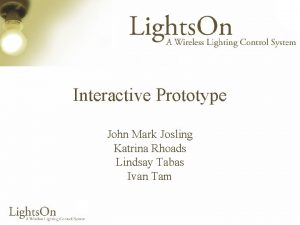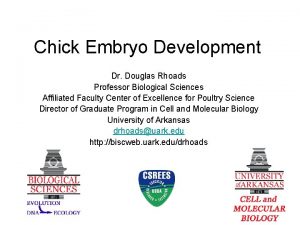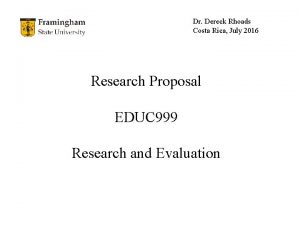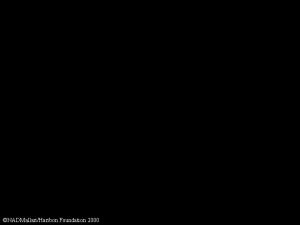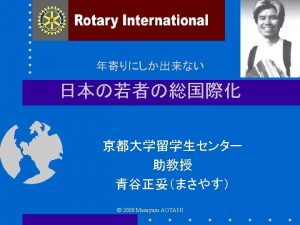The LALA Survey Rhoads et al 2000 The



































- Slides: 35

The LALA Survey Rhoads et al. 2000

The LALA Survey Rhoads et al. 2000

The LALA Survey Rhoads et al. 2000

Subaru and Supreme Taniguchi et al. 2004

Subaru and Supreme Taniguchi et al. 2004

Blind spectroscopy searches • Martin et al. 2006: ultra-sensitive spectroscopic survey of Lya emitters at z~5. 7 • Multi-slit windows technique complements other emission-line surveys. • Narrow-band imaging surveys cover large areas of sky but only detect much brighter objects. Long-slit spectra taken along cluster caustics yield intrinsically fainter lensed Lya emitters but probe small volumes of space. • To a line flux limit of a few times 10^-18 erg/s/cm^2, we found 150 emission-line sources with no detectable continuum. • These candidates are being re-observed with broad spectral coverage to determine the line identity. To date, the interloper to Lya ratio is about 8: 1. • The sky positions of the Lya candidates generally do not coincide with those of foreground objects in ultra-deep r band or i' images -- consistent with the presence of a strong Lyman break.

Blind spectroscopy searches

Blind spectroscopy searches

Lya survey to constraints reionization Malhotra et al. 2006 The observed number density of Lya sources at z~6. 5 implies a minimum volume of the intergalactic medium that must be ionized, in order to allow the Lya photons to escape attenuation. Volume estimated by assigning to each Lya emitter the minimum ionized bubble that would allow half its Lya photons to escape. This implies a lower limit to the ionized gas volume fraction of 20%-50% at z=6. 5. This limit is completely independent of what ionizing photon sources produced the bubbles. Deeper Lya surveys are possible with present technology and can strengthen these limits by detecting a higher density of Lya galaxies.

Lya Surveys: Implications for Galaxy Formation Dawson et al. 2004 Keck low resolution optical spectra of 17 Lya galaxies and one Lyman break galaxy at z~4. 5 discovered in the Large Area Lyman Alpha survey (LALA). Sample of ~350 candidate Lya galaxies at z~4. 5 in a search volume of 1. 5× 106 comoving Mpc 3. Targeted 25 candidates for spectroscopy; the 18 confirmations suggest a selection reliability of 72%. The large rest equivalent widths (median Wl ~80 Å) but narrow physical widths (Deltav<500 km s-1) of the Lya emission lines, and the lack of accompanying high-ionization emission lines, suggest that these galaxies are young systems powered by star formation rather than by AGN. Theoretical models of galaxy formation suggest that a small fraction of Lya galaxies at z~4. 5 may still be nascent, metal-free objects. Indeed, we find with 90% confidence that three to five of the confirmed sources show Wl >240 Å, exceeding the maximum predicted for normal stellar populations. Nonetheless, we find no evidence for He. II l 1640 emission in either individual or composite spectra, indicating that although these galaxies are young, they are not truly primitive, Population III objects.

Lya Surveys: z~7

Lya Surveys: z~7

Lya Surveys: z~7

Galaxies at z~9? Willis & Courbin 2005

Lya Surveys: Searching for First Light Near-IR search for galaxies At z=9. 17 Mannucci et al. 2006

Lya Surveys: Searching for First Light Mannucci et al.

Emission Line Surveys Lecture 4 Mauro Giavalisco Space Telescope Science Institute University of Massachusetts, Amherst 1 1 From January 2007

Lya searches to complement continuum ones Steidel et al. 1999

Finding high-redshift galaxies: color selection 1. Color selection is very efficient in finding galaxies with specific spectral types in a pre-assigned redshift range 2. Wide variety of methods available, targeting a range of redshifts, galaxies’ SEDs: • Lyman and Balmer break (Steidel, Adelberger, MG) • DRG (Franx, Labbe et al. ) • Bz. K (Daddi et al. ) • Photo-z (Mobasher et al) B 435 z 850 V 606 i 775 Unattenuated Spectrum Attenuated by IGM z~4 Here, the case of “Lyman-break galaxies” GOODS yielded the deepest and largest quality samples of LBGs at z~4 to ~6 (7? ) B 435 V 606 z 850

Color selection at z>3 B-band dropouts: 3. 5<z<4. 5 Vanzella et al. 2006

Color selection at z>3 V-band dropouts: 4. 5<z<5. 5

Color selection at z>3 i-band dropouts: 5. 5<z<6. 5

Color selection at z>3 z-band dropouts: 6. 5<z<7. 5

The Redshift Distribution LBGs at z>3 are targets of the ongoing GOODS spectroscopic time with the ESO VLT and Keck #183 #27 Vanzella et al. 2005, 2006 in prep. Stern et al. 2006 in prep. Giavalisco et al. 2004; 2006, in prep.

Lya searches to complement continuum ones Steidel et al. 1999

Lya searches to complement continuum ones Steidel et al. 1999 At faint end of LF, Lya emitters might dominate the LF SFD underestimated by as much as 2 x Other important works by: Hu et al. 2001 Ouchi et al. 2004 Taniguchi et al. 2004

Lya searches to complement continuum ones Results from the GOODS survey (Giavalisco et al. 2004) Vanzella et al. 2006

Lya searches to complement continuum ones Vanzella et al. 2006

Lya searches to complement continuum ones Vanzella et al. 2006

Lya searches to complement continuum ones Vanzella et al. 2006

Lya searches to complement continuum ones Vanzella et al. 2006

Lya searches to complement continuum ones Vanzella et al. 2006

Lya searches to complement continuum ones Vanzella et al. 2006

What is causing the difference in the spectra? “Absorbers” tend to be redder than emitter. However, there are blue “absorbers”, too. No strong correlation of spectral “types” with the ellipticity of the galaxies. Are these disks? Possibly an effect of geometry of gas and dust, metallicity and age (see Shapley et al. 2004). Abs. Em.

Color selection at z~2: Bz. K galaxies Bz. K selection: 1. 4<z<2. 5 Bz. K selection well suited for 24 mm MIPS studies: • Selected range 1. 4 < z < 2. 5 places strong mid-IR features in 24 mm band • Color selection includes objects with red UV continuum, e. g. , from extinction • K-band selection suitable for relatively massive galaxies (Daddi et al. 2005)
 Lala rhoads
Lala rhoads Russell rhoads
Russell rhoads Lala rhoads
Lala rhoads Lala rochdale
Lala rochdale Ano ang kolokyal na salita
Ano ang kolokyal na salita Estructura organizacional de lala
Estructura organizacional de lala Trixie lala
Trixie lala Jenis jenis evaluasi
Jenis jenis evaluasi 叫叫 abcd
叫叫 abcd Công thức tiính động năng
Công thức tiính động năng Thế nào là mạng điện lắp đặt kiểu nổi
Thế nào là mạng điện lắp đặt kiểu nổi Các loại đột biến cấu trúc nhiễm sắc thể
Các loại đột biến cấu trúc nhiễm sắc thể Bổ thể
Bổ thể Vẽ hình chiếu đứng bằng cạnh của vật thể
Vẽ hình chiếu đứng bằng cạnh của vật thể Phản ứng thế ankan
Phản ứng thế ankan Môn thể thao bắt đầu bằng từ chạy
Môn thể thao bắt đầu bằng từ chạy Khi nào hổ mẹ dạy hổ con săn mồi
Khi nào hổ mẹ dạy hổ con săn mồi Thiếu nhi thế giới liên hoan
Thiếu nhi thế giới liên hoan điện thế nghỉ
điện thế nghỉ Một số thể thơ truyền thống
Một số thể thơ truyền thống Thế nào là sự mỏi cơ
Thế nào là sự mỏi cơ Trời xanh đây là của chúng ta thể thơ
Trời xanh đây là của chúng ta thể thơ Các số nguyên tố là gì
Các số nguyên tố là gì Tỉ lệ cơ thể trẻ em
Tỉ lệ cơ thể trẻ em Tia chieu sa te
Tia chieu sa te Các châu lục và đại dương trên thế giới
Các châu lục và đại dương trên thế giới Thế nào là hệ số cao nhất
Thế nào là hệ số cao nhất Sơ đồ cơ thể người
Sơ đồ cơ thể người Tư thế ngồi viết
Tư thế ngồi viết đặc điểm cơ thể của người tối cổ
đặc điểm cơ thể của người tối cổ Cái miệng bé xinh thế chỉ nói điều hay thôi
Cái miệng bé xinh thế chỉ nói điều hay thôi Hát kết hợp bộ gõ cơ thể
Hát kết hợp bộ gõ cơ thể Cách giải mật thư tọa độ
Cách giải mật thư tọa độ Tư thế ngồi viết
Tư thế ngồi viết ưu thế lai là gì
ưu thế lai là gì Gấu đi như thế nào
Gấu đi như thế nào
